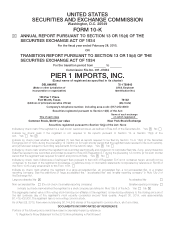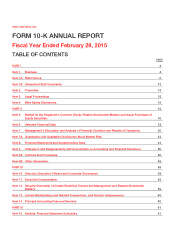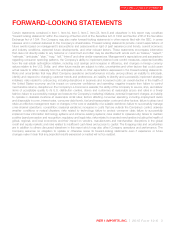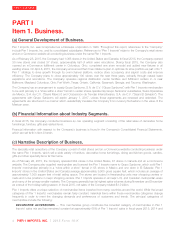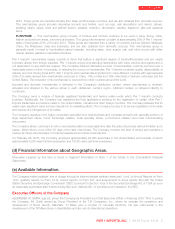Pier 1 2015 Annual Report Download - page 17
Download and view the complete annual report
Please find page 17 of the 2015 Pier 1 annual report below. You can navigate through the pages in the report by either clicking on the pages listed below, or by using the keyword search tool below to find specific information within the annual report.
ITEM 1A. RISK FACTORS.
solutions and data storage. The Company believes it is taking appropriate actions to ensure the successful implementation of
these initiatives, including the testing of new systems and the transfer of existing data, with minimal disruptions to the business.
However, there can be no assurance the Company has anticipated all potential risks. Failure to successfully implement these
initiatives could negatively impact the business and its financial results.
The Company’s business operations including the expansion of the Company’s e-
Commerce website, are subject to inherent cybersecurity risks that may disrupt its business
and negatively impact the Company’s financial results and reputation.
The Company’s e-Commerce functionality has increased the Company’s exposure to cybersecurity risks. A compromise of its
security systems could result in a service disruption, or customers’, associates’ or vendors’ personal information or the
Company’s proprietary information being obtained by unauthorized users. Although the Company has implemented processes to
mitigate the risks of security breaches and cyber incidents, there can be no assurance that such an attack will not occur. Any
breach of the Company’s security could result in violation of privacy laws, potential litigation or regulatory action, and a loss of
consumer confidence in its security measures, all of which could have a negative impact on the Company’s financial results and
its reputation.
Failure to maintain positive brand perception and recognition could have a negative impact
on the Company’s financial results and reputation.
Maintaining a good reputation is critical to the Company’s business. The considerable expansion in the use of social media over
recent years has increased the risk that the Company’s reputation could be negatively impacted in a short amount of time. If the
Company is unable to quickly and effectively respond to occurrences of negative publicity through social media or otherwise, it
may suffer declines in customer loyalty and traffic, vendor relationship issues, diversion of management’s time to respond and
other adverse effects, all of which could negatively impact the Company’s financial results and its reputation.
Regulatory Risks
The Company is subject to laws and regulatory requirements in many jurisdictions. Changes
in these laws and requirements, or interpretations of them, may result in additional costs to
the Company, including the costs of compliance as well as potential penalties and fines for
non-compliance.
Legislation on a local, regional, state, national or global level has the potential to have a negative effect on the Company’s
profitability or ability to operate its business. Compliance with certain legislation carries with it significant costs. The Company is
subject to oversight by many governmental and quasi-governmental agencies in the course of operating its business because of
its numerous locations, large number of associates, contact with consumers and importation and exportation of product. In
addition, the Company is subject to regulations regarding consumer product quality and safety standards. Complying with
regulations may cause the Company to incur significant expenses, including the costs associated with periodic audits. Failure to
comply may also result in damage to the Company’s reputation or additional costs in the form of litigation, financial penalties and
fines or business interruptions.
The Company operates in many taxing jurisdictions, including foreign countries. In most of these jurisdictions, the Company is
required to collect state and local sales taxes at the point of sale and remit such taxes to the appropriate taxing authority. The
Company is also subject to income taxes, excise taxes, franchise taxes, payroll taxes and other special taxes. The Company is
also required to maintain various kinds of business and commercial licenses to operate its stores and other facilities. Rates of
taxation are beyond the Company’s control, and increases in such rates or taxation methods and rules could have a negative
impact on the Company’s financial results. Failure to comply with laws concerning the collection and remittance of taxes and with
licensing requirements could also subject the Company to financial penalties and fines or business interruptions.
Risks Associated with International Trade
As an importer and retailer of imported merchandise, the Company is subject to certain
risks that typically do not affect retailers of domestically produced merchandise.
The Company must order merchandise well in advance of delivery and generally takes title to the merchandise at the time it is
loaded for transport to designated U.S. destinations. Global political unrest, war, threats of war, terrorist acts or threats, especially
threats to foreign and U.S. ports and piracy, disruption in the operation of the international portion of the Company’s supply
PIER 1 IMPORTS, INC. 2015 Form 10-K 11


